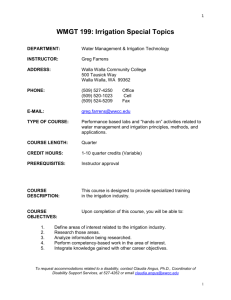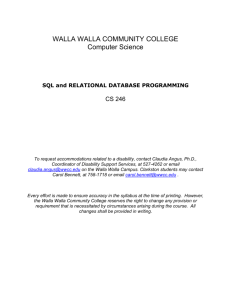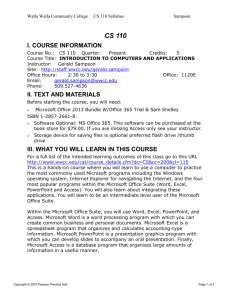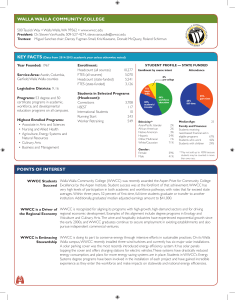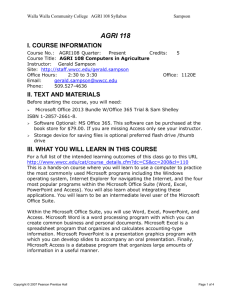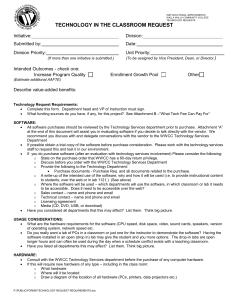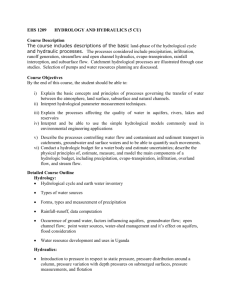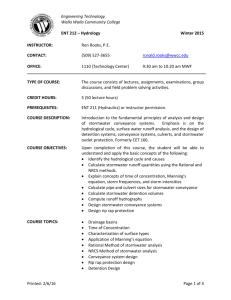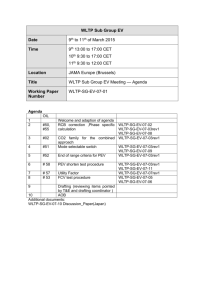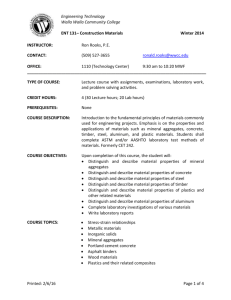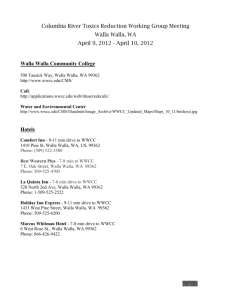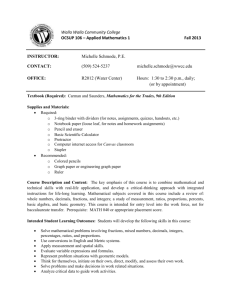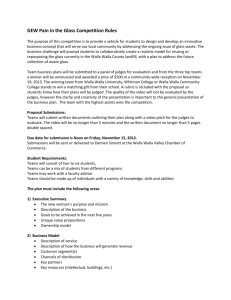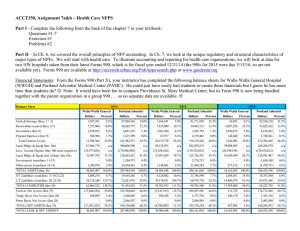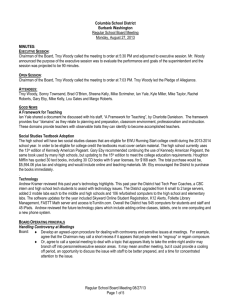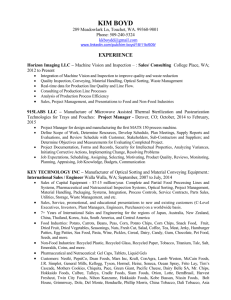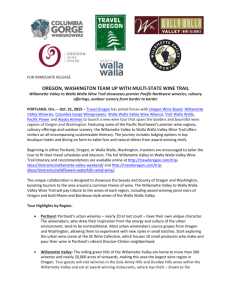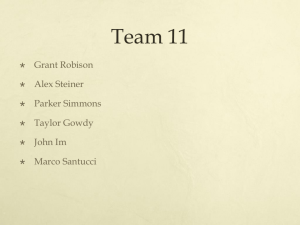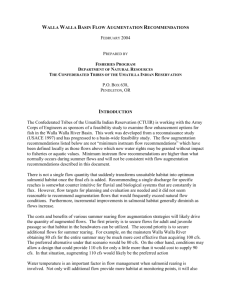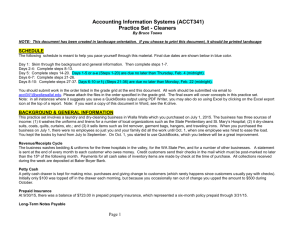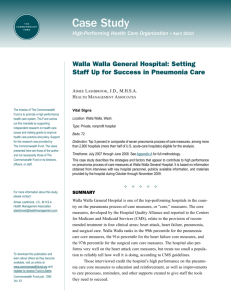View Syllabus - Walla Walla Community College
advertisement
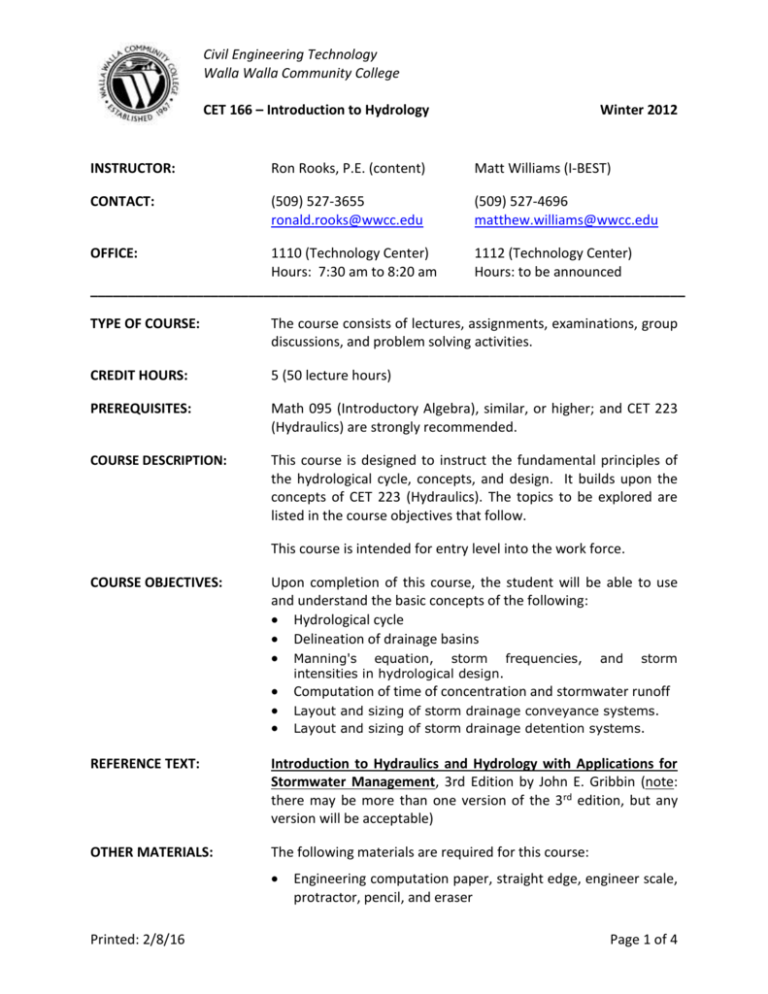
Civil Engineering Technology Walla Walla Community College CET 166 – Introduction to Hydrology Winter 2012 INSTRUCTOR: Ron Rooks, P.E. (content) Matt Williams (I-BEST) CONTACT: (509) 527-3655 ronald.rooks@wwcc.edu (509) 527-4696 matthew.williams@wwcc.edu OFFICE: 1110 (Technology Center) 1112 (Technology Center) Hours: 7:30 am to 8:20 am Hours: to be announced _______________________________________________________________________________ TYPE OF COURSE: The course consists of lectures, assignments, examinations, group discussions, and problem solving activities. CREDIT HOURS: 5 (50 lecture hours) PREREQUISITES: Math 095 (Introductory Algebra), similar, or higher; and CET 223 (Hydraulics) are strongly recommended. COURSE DESCRIPTION: This course is designed to instruct the fundamental principles of the hydrological cycle, concepts, and design. It builds upon the concepts of CET 223 (Hydraulics). The topics to be explored are listed in the course objectives that follow. This course is intended for entry level into the work force. COURSE OBJECTIVES: Upon completion of this course, the student will be able to use and understand the basic concepts of the following: Hydrological cycle Delineation of drainage basins Manning's equation, storm frequencies, and storm intensities in hydrological design. Computation of time of concentration and stormwater runoff Layout and sizing of storm drainage conveyance systems. Layout and sizing of storm drainage detention systems. REFERENCE TEXT: Introduction to Hydraulics and Hydrology with Applications for Stormwater Management, 3rd Edition by John E. Gribbin (note: there may be more than one version of the 3rd edition, but any version will be acceptable) OTHER MATERIALS: The following materials are required for this course: Printed: 2/8/16 Engineering computation paper, straight edge, engineer scale, protractor, pencil, and eraser Page 1 of 4 Civil Engineering Technology Walla Walla Community College CET 166 – Introduction to Hydrology Winter 2012 Scientific Calculator (with trigonometric, radian, and root function capability at minimum) Recommended (not required): spreadsheet software Laptop computers with COURSE EXPECTATIONS: 1) BEHAVIOR: Policies regarding behavior shall adhere to the current edition of the WWCC Student Handbook. This includes, but is not limited to, code of conduct, cheating, and plagiarism. Additional guidelines are included below. ATTENDANCE: Attend class on time! You are considered absent once role is taken. No more than one unexcused absence is acceptable. Excused absences are ones cleared with me PRIOR to class. Two excused absences are equivalent to one unexcused absence. Each student who has one or less absences earns a bonus. If you are unable to attend class for any reason, please call me BEFORE CLASS. Assignments due shall be turned in the next time you are in class. No exception. 2) ASSIGNMENTS: Homework shall be completed per “HOMEWORK GUIDELINES” listed below. Assignments are due BEFORE CLASS on the day scheduled. No late work is accepted. You may turn assignments in early or send it with someone to turn in. Work shall not be returned until after the due date. Each assignment is worth 10 points. Full score may be awarded if it is turned in on time, completed in the proper format and process, worked completely, and self-corrected. 3) TESTS: Tests include chapter and final examinations and quizzes. A missed text will be awarded a score of zero. Late tests shall not be given. Unavoidable exceptions may be considered, but not if a pattern persists. Excused circumstances must be acceptable to and cleared with the instructor PRIOR to the test. Your OWN homework, class notes, calculator, and text book are allowed for use during examinations. Being organized is imperative as a skill set in the work force. Therefore, it is strongly recommended that you organize your work into a 3-ring binder with dividers for reference. It is also recommended to attach labeled tabs in your text book for quick reference also. 4) ELECTRONIC DEVICE USAGE: Electronic devices are helpful and well integrated into society. However, appropriate use must be maintained. The following expectations shall apply. If breached, then you will be asked to leave class and receive a zero score for either work or test due that day. Printed: 2/8/16 Page 2 of 4 Civil Engineering Technology Walla Walla Community College CET 166 – Introduction to Hydrology Winter 2012 a) Phones must be OFF or set to “vibrate”. NO TEXTING is allowed. b) Calculators only are allowed in class or tests. NO PDAs or phone substitutes. 5) DISABILITY: If you have a disability and need accommodations, inform the instructor and contact Claudia Angus, Coordinator of Disability/Support Services at claudia.angus@wwcc.edu or 527-4543 to seek accommodations. She is located in Office 133D, Student Development Area. Failure to obtain accommodations will subject the student to the same accommodations as the remainder of the students. 6) EVALUATION SUMMARY: Evaluation of the student’s final grade will be based upon the following components and their assigned proportions. See Evaluation Summary for final grade. Component Total Points Homework: 300 Chapter Examinations: 500 Final Examination: 200 TOTAL: 1000 Attendance Bonus: 30 The student’s final grade will be based upon the total points scored from each component of course evaluation. Additionally, one’s grade is subject to preparation, timeliness, and neatness of work completed at the instructor’s discretion. The student’s final grade will be determined from their total points scored as follows: Percentage 93-100% 90-92.9% 87-89.9% 83-86.9% 80-82.9% 77-79.9% 73-76.9% 70-72.9% 65-69.9% 60-64.9% <60% Printed: 2/8/16 Total Points Scored 930-1000 900-929 870-899 830-869 800-829 770-799 730-769 700-729 650-699 600-649 <600 Final Grade A AB+ B BC+ C CD+ D F Page 3 of 4 Civil Engineering Technology Walla Walla Community College CET 166 – Introduction to Hydrology Winter 2012 HOMEWORK GUIDELINES Homework must be completed according to the following guidelines to receive credit or it will receive deductions and be deemed late at the instructor’s discretion. Use engineering computation paper, front side only. Use pencil only, preferably 0.5 or 0.7 mm, with soft lead. NO INK! Label TOP of ALL pages: a) course number, b) first and last name, c) assignment, d) date Place page indicators (i.e. 1 / 1) in the upper right-hand corner. The first number is the current page. The second is the total number of pages in the assignment. Place a line at the end of each exercise to indicate where it concluded. It should be written as 3 “-“ and 2 “/” and stretch completely across the page as shown: ----------------------------------------//------------------------------------//------------------------------------- Make your work clear and neat. The instructor will not decipher it. Neatness includes usage of page lines, a straight-edge or other guides for sketches, and non-tattered paper. FORMAT: Each exercise shall be completed in the following manner in order: Given Statement: (This helps begin to organize your work) o List all the important information given in the exercise. o Write it in your own words. o Give enough information that someone reviewing the exercise will know what was given. Find Statement: (This clarifies what you are seeking to determine) o List and deliberate what you are asked to solve. o Write it in your own words. o Annotate each part by using lettering or numbering (a, b, c or 1, 2, 3) as needed. Sketch (if appropriate): (This provides a visual aid to help understand the exercise) o Draw or sketch the exercise. Take enough time to draw it clearly. o Use a straight edge and template where applicable. Be proportionate the best you can. Solution: (This is where the bulk of your work occurs in determining the answer) o List items that are not given in the exercise that you should know. (i.e. formulas) o State any assumptions you might make and justify why you are making them. Answer: o Clearly indicate all your answers. Use a box. o Note answer with “ANS” in the right margin and point to the answer with an arrow. o Be clear so someone checking your work does not need to search for the answer. Printed: 2/8/16 Page 4 of 4
